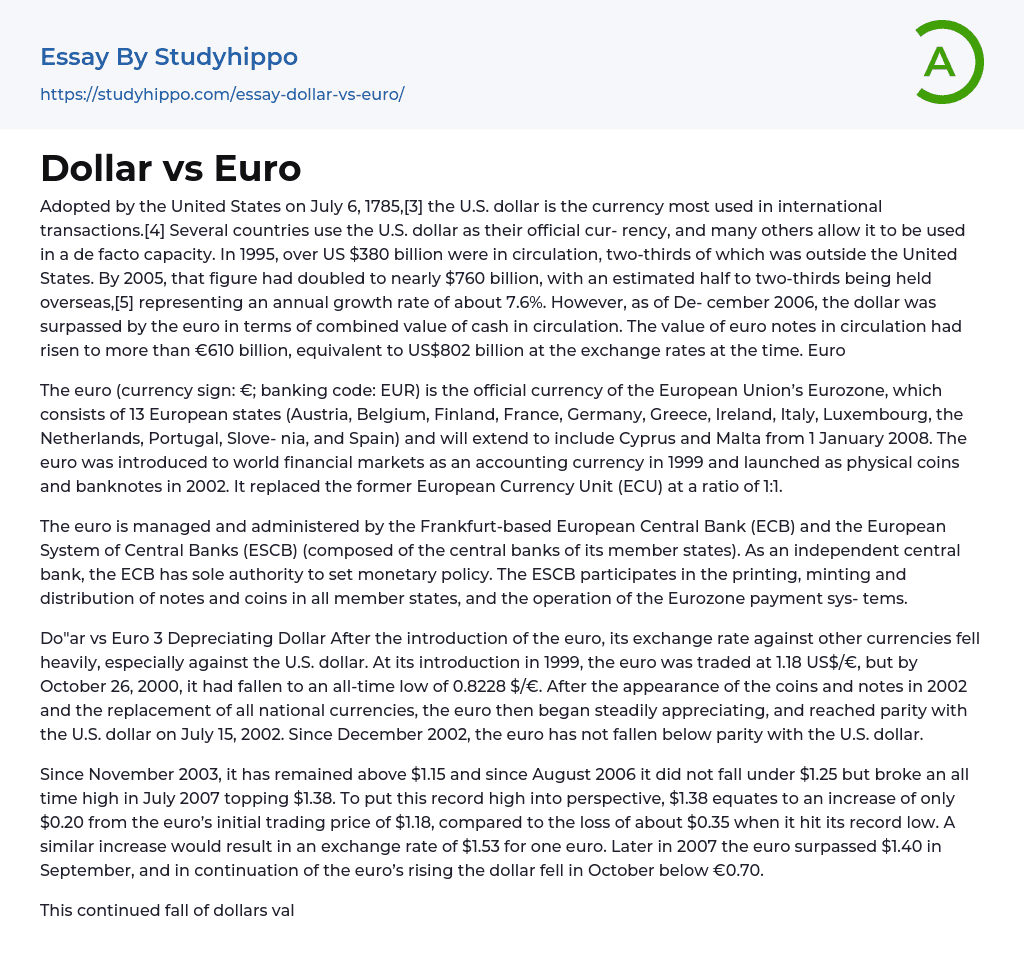Adopted by the United States on July 6, 1785,[3] the U.S. dollar is the currency most used in international transactions.[4] Several countries use the U.S. dollar as their official cur- rency, and many others allow it to be used in a de facto capacity. In 1995, over US $380 billion were in circulation, two-thirds of which was outside the United States. By 2005, that figure had doubled to nearly $760 billion, with an estimated half to two-thirds being held overseas,[5] representing an annual growth rate of about 7.6%. However, as of De- cember 2006, the dollar was surpassed by the euro in terms of combined value of cash in circulation. The value of euro notes in circulation had risen to more than €610 billion, equivalent to US$802 billion at the exchange rates at the time. Euro
The euro (currency sign: €; banking code: EUR) is
...the official currency of the European Union’s Eurozone, which consists of 13 European states (Austria, Belgium, Finland, France, Germany, Greece, Ireland, Italy, Luxembourg, the Netherlands, Portugal, Slove- nia, and Spain) and will extend to include Cyprus and Malta from 1 January 2008. The euro was introduced to world financial markets as an accounting currency in 1999 and launched as physical coins and banknotes in 2002. It replaced the former European Currency Unit (ECU) at a ratio of 1:1.
The euro is managed and administered by the Frankfurt-based European Central Bank (ECB) and the European System of Central Banks (ESCB) (composed of the central banks of its member states). As an independent central bank, the ECB has sole authority to set monetary policy. The ESCB participates in the printing, minting and distribution of
notes and coins in all member states, and the operation of the Eurozone payment sys- tems.
Do"ar vs Euro 3 Depreciating Dollar After the introduction of the euro, its exchange rate against other currencies fell heavily, especially against the U.S. dollar. At its introduction in 1999, the euro was traded at 1.18 US$/€, but by October 26, 2000, it had fallen to an all-time low of 0.8228 $/€. After the appearance of the coins and notes in 2002 and the replacement of all national currencies, the euro then began steadily appreciating, and reached parity with the U.S. dollar on July 15, 2002. Since December 2002, the euro has not fallen below parity with the U.S. dollar.
Since November 2003, it has remained above $1.15 and since August 2006 it did not fall under $1.25 but broke an all time high in July 2007 topping $1.38. To put this record high into perspective, $1.38 equates to an increase of only $0.20 from the euro’s initial trading price of $1.18, compared to the loss of about $0.35 when it hit its record low. A similar increase would result in an exchange rate of $1.53 for one euro. Later in 2007 the euro surpassed $1.40 in September, and in continuation of the euro’s rising the dollar fell in October below €0.70.
This continued fall of dollars value has much to do with his decreasing role as the world’s reserve currency as predicted by Alan Greenspan and many others, like Jim Rogers. Additionally, Jim Rogers declared that he quits dollar as he think its value will fall even further, especially against the Chinese yuan. Chinese officials signaled plans to diversify the nation’s $1.43
trillion reserves in response to a falling U.S. currency which also set the dollar under pressure. On 23 May 2003, the euro surpassed its initial ($1.18) trading value for the first time.
At the end of 2004, it reached a peak of $1.3668 (0.7316 €/$) as the U.S. dollar fell against all major currencies, fuelled by the so-called double deficit in the US accounts. But the dol- lar recovered in 2005, rising to $1.18 (0.85 €/$) in July 2005, and was stable throughout the second half of 2005. The steep increase in U.S. interest rates during 2005 had much to do with this trend. By early December 2006, the dollar had fallen below €0.75, hitting a low of 0.7495 €/$ (1.3340 $/€), slightly more than 3 cents above its record low, set in late 2004.
One of the reasons was an interest rate reduction by the Federal Reserve in September 18, 2007, that raised the euro’s value significantly and caused the dollar to fall below €0.70 one month later, marking a new record low. Economists like Alan Greenspan suggest that another reason for the continued fall of the dollar’s value is its decreasing role as the world’s re- serve currency. Chinese officials signaled plans to diversify the nation’s $1.43 trillion re- serves in response to a falling U.S. currency which also set the dollar under pressure. On November 7, 2007, the dollar fell to an all-time low at $1.4722 against the euro.
- Commercial Bank essays
- Debit Card essays
- Deposit Account essays
- Subprime Lending essays
- Auction essays
- Balanced Scorecard essays
- Business Plans essays
- Expense essays
- Income essays
- Net Income essays
- Security Guard essays
- Singapore Airlines essays
- Battle essays
- Intranet essays
- Maintenance essays
- Simulation essays
- Inn essays
- Qualities essays
- John Locke essays
- 9/11 essays
- A Good Teacher essays
- A Healthy Diet essays
- A Modest Proposal essays
- A&P essays
- Academic Achievement essays
- Achievement essays
- Achieving goals essays
- Admission essays
- Advantages And Disadvantages Of Internet essays
- Alcoholic drinks essays
- Ammonia essays
- Analytical essays
- Ancient Olympic Games essays
- APA essays
- Arabian Peninsula essays
- Argument essays
- Argumentative essays
- Art essays
- Atlantic Ocean essays
- Auto-ethnography essays
- Autobiography essays
- Ballad essays
- Batman essays
- Binge Eating essays
- Black Power Movement essays
- Blogger essays
- Body Mass Index essays
- Book I Want a Wife essays
- Boycott essays
- Breastfeeding essays




